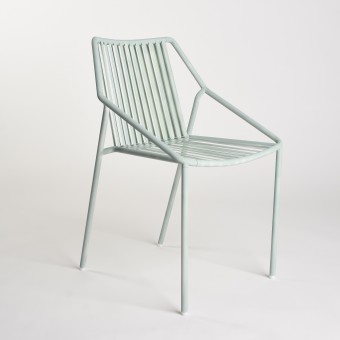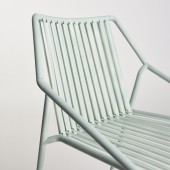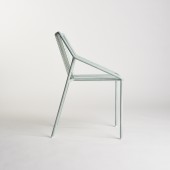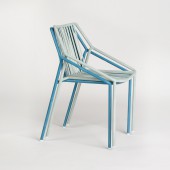
| THE AWARD |
| CATEGORIES |
| REGISTRATION |
| SUBMIT YOUR WORK |
| ENTRY INSTRUCTIONS |
| TERMS & CONDITIONS |
| PUBLICATIONS |
| DATES & FEES |
| METHODOLOGY |
| CONTACT |
| WINNERS |
| PRESS ROOM |
| GET INVOLVED |
| DESIGN PRIZE |
| DESIGN STORE |
| THE AWARD | JURY | CATEGORIES | REGISTRATION | PRESS | WINNERS | PUBLICATIONS | ENTRY INSTRUCTIONS |
Tomeo Outdoor Metallic Chair by Hugo Charlet-berguerand |
Home > Winners > Design #101890 >Interview |
 |
|
FS: What is the main principle, idea and inspiration behind your design?
HC: Tomeo is an outdoor metal chair made from bent metal pipes. It is a light and stackable chair initially thought to offer an elegant and robust alternative to plastic chairs for the outdoors. The idea is in the structure which has a unique geometry, the rear legs pass in front of the backrest and turn back to join on the top of the backrest. Thus the back rest angle is different from the rear legs‘ angle.
FS: What has been your main focus in designing this work? Especially what did you want to achieve?
HC: The aim was to design a chair that would be appealing both in the eyes of the consumer, meeting best design quality and market trends but also to be interesting in the eyes of the industrialist. Considerable efforts were dedicated to make an industrializable product with a reasonable production cost yet unique look.
FS: What are your future plans for this award winning design?
HC: My Goal is to promote my award-winning design Tomeo as well as my other realizations and start collaborations with furniture manufacturers. I am currently less focused on designing new products, I spend more time on promoting my work and trying to get visibility in order to find clients and start new collaborations.
FS: How long did it take you to design this particular concept?
HC: More or less one month and a half.
FS: Why did you design this particular concept? Was this design commissioned or did you decide to pursuit an inspiration?
HC: This chair is the work I presented for my master’s degree graduation project.
FS: Is your design being produced or used by another company, or do you plan to sell or lease the production rights or do you intent to produce your work yourself?
HC: I would like to find an agreement with a manufacturer to lease the production rights, I aim to work as a furniture designer, so I don’t want to produce my designs myself forever.
FS: What made you design this particular type of work?
HC: The observation that wherever one looks, restaurant terraces remain filled with plastic chairs. I realised that the market’s offer in terms of metal chairs was really limited. Moreover, metallic furniture manufacturers sometimes do little more than re-publishing furniture designed during the early 20th century. Furthermore, the theme of outdoor furniture has always been of strong interest to me, that’s why I especially wanted to design this type of chair.
FS: Where there any other designs and/or designers that helped the influence the design of your work?
HC: My worked is always tinted from the influence of the designers and artists I admire.
FS: Who is the target customer for his design?
HC: This is supposed to be an affordable chair addressed to everybody.
FS: What sets this design apart from other similar or resembling concepts?
HC: Tomeo’s uniqueness comes from its original structure. Tomeo’s structure has a surprising and innovative geometry which clearly differentiates it from other products on the market. It is as if the skeleton of the chair has come out of its body: the seat is narrower than the backrest at the rear and the chair legs jut out towards the sides. The armrests protrude from the backrest at a forty-five-degree angle to meet the front chair legs. The feet are directly below the front edge of the seat giving the impression that the seat and the backrest are suspended inside the structure.
FS: How did you come up with the name for this design? What does it mean?
HC: When I started this project, I was working at Michele de Lucchi’s office in Milan. Anybody interested in furniture design surely knows the iconic lamp architect Michele de Lucchi designed for Artemide: Toloméo. This best seller contributed to make him the worldwide known designer we know nowadays. I gave a similar name to my design to bring me luck and because I liked this short and friendly name.
FS: Which design tools did you use when you were working on this project?
HC: I worked on Rhino3D and Keyshot for the drawing part. For the prototyping, I worked with 3D printers and many different machines available at Politecnico di Milano’s workshops.
FS: What is the most unique aspect of your design?
HC: It is really a product that would easily find its place in the market. It’s contemporary and elegant look. It’s reasonable price would allow it to be a very competitive product. Moreover, the branch of metallic furniture is extremely trendy nowadays with the very bad image plastic drags. But the market remains sparsely populated with metal furniture, and few pieces are well designed, most of it are reproduction of early 20century’s designs (bistrot chair, Luxembourg, …). There is space, even a need on the market for such a chair.
FS: Who did you collaborate with for this design? Did you work with people with technical / specialized skills?
HC: I did everything alone but tried to seek out feedback from as various inputs as possible along the way.
FS: What is the role of technology in this particular design?
HC: This design is thought to be easily manufacturable with classic technologies used in the furniture industry.
FS: Is your design influenced by data or analytical research in any way? What kind of research did you conduct for making this design?
HC: I lived two years in Milan, and I had the opportunity to visit Italian leading furniture brands, I also participated to many different furniture fairs. I am always on the lookout for new products and market trends. Additionally, in my everyday life I tend to keep an eye on the furniture in restaurants bars, hotels, eetc. Wherever I go.
FS: What are some of the challenges you faced during the design/realization of your concept?
HC: The prototyping phase was sometimes tricky and required a very delicate and attentive work to achieve the desired quality.
FS: How did you decide to submit your design to an international design competition?
HC: I was satisfied with my work and I wanted to promote it.
FS: What did you learn or how did you improve yourself during the designing of this work?
HC: A very tricky part when designing a chair is to adjust the dimensions. Indeed, you’re not going to be able to sit on it before a long time, so it is a big challenge not to make mistakes on the proportions when you work on a computer. Another difficulty was to make this chair stackable. Designing a stackable chair is far from being trivial, I struggled quite a lot to achieve such without affecting the initial look too much. Then I had to prepare the prototype’s fabrication which required to go much more into details in your drawings. I had to separate my chair in straight and curved sections and to design the joins. And I also had to figure out how to 3D print objects…
FS: Thank you for providing us with this opportunity to interview you.
A' Design Award and Competitions grants rights to press members and bloggers to use parts of this interview. This interview is provided as it is; DesignPRWire and A' Design Award and Competitions cannot be held responsible for the answers given by participating designers.
| SOCIAL |
| + Add to Likes / Favorites | Send to My Email | Comment | View Press-Release | Translations |





